| Listing 1 - 10 of 16 | << page >> |
Sort by
|
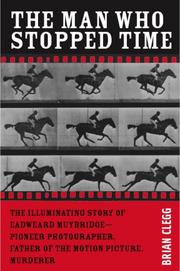
ISBN: 9780309101127 0309101123 Year: 2007 Publisher: Washington, D.C. : Joseph Henry Press,
Abstract | Keywords | Export | Availability | Bookmark
 Loading...
Loading...Choose an application
- Reference Manager
- EndNote
- RefWorks (Direct export to RefWorks)
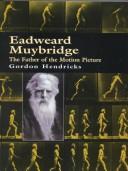
ISBN: 0436192705 Year: 1975 Publisher: London : Secker and Warburg,
Abstract | Keywords | Export | Availability | Bookmark
 Loading...
Loading...Choose an application
- Reference Manager
- EndNote
- RefWorks (Direct export to RefWorks)
Book
ISBN: 0486202046 9780486202044 Year: 1955 Publisher: New York Dover Publications
Abstract | Keywords | Export | Availability | Bookmark
 Loading...
Loading...Choose an application
- Reference Manager
- EndNote
- RefWorks (Direct export to RefWorks)
Eadweard James Muybridge était un photographe anglais important pour son travail pionnier dans les études photographiques du mouvement, et ses premiers travaux dans la projection cinématographique. Dans les années 1880, Muybridge est entré dans une période très productive à l’Université de Pennsylvanie à Philadelphie, produisant plus de 100 000 images d’animaux et d’humains en mouvement, capturant ce que l’œil humain ne pouvait pas distinguer comme des mouvements séparés. Il a passé une grande partie de ses dernières années à donner des conférences publiques et des démonstrations de ses photographies et de ses premières séquences cinématographiques, retournant en Angleterre et en Europe pour faire connaître son travail. Il a également édité et publié des compilations de son travail, qui ont grandement influencé les artistes visuels et les domaines en développement de la photographie scientifique et industrielle. Dans "The human figure in motion", les séquences montrent des études de mouvement du corps masculin ou féminin dans diverses situations : dans le cas des hommes, il s’agit principalement de phases de mouvement pendant l’exercice du sport (sprint, course, saut en longueur, saut en hauteur, lancer, lancer du poids, baseball, cricket, aviron, lutte, escrime, boxe), dans des situations quotidiennes (marcher, porter des poids, monter une ascension, monter des escaliers, etc.) ou lors d’un travail physique (marcher avec un fusil, forger, creuser). Dans le cas des études sur le mouvement féminin, il existe une approche plus esthétique, qui est évidemment due à la compréhension morale de l’époque victorienne : seule une partie des modèles féminins a été photographiée nue.
611 --- 77.092.07 --- Beweging in de fotografie --- Fotografen Eadweard Muybridge --- Muggeridge, Edward James --- Muybridge, Eadweard (pseudoniem van Edward Muggeridge) 1830-1904 (°Kingston-on-Thames, Groot-Brittannië) --- Thema's in de fotografie menselijk lichaam --- 77.041 --- Muybridge Eadweard --- beweging --- fotografie --- mens --- negentiende eeuw --- Verenigde Staten --- 761 --- Muybridge, Eadweard --- geschiedenis --- Anatomie --- Fotografen A - Z --- fotografie, geschiedenis --- Fotografen ; Eadweard Muybridge --- Thema's in de fotografie ; menselijk lichaam --- Cinétique --- Photographie --- Photographe --- 19e siècle
Book
ISBN: 0920785379 0920785395 0262082209 0262581213 9780920785379 9780920785393 9780262082204 9780262581219 Year: 1993 Publisher: Montréal Canadian Centre for Architecture
Abstract | Keywords | Export | Availability | Bookmark
 Loading...
Loading...Choose an application
- Reference Manager
- EndNote
- RefWorks (Direct export to RefWorks)
In 1990 the Canadian Centre for Architecture acquired a copy of Eadweard Muybridge's rare mammoth-plate "Panorama of San Francisco from California Street Hill." Made in 1878 from the top of the Mark Hopkins mansion, this 360-degree photograph of the city, over five metres in length, was not only a remarkable technical achievement but a high point in the history of city view-making. David Harris, curator of the exhibition which this publication accompanies, examines in his essay the photographer's role in creating and imposing an aesthetic order upon the apparent haphazardness of the city, concentrating upon the technical and conceptual issues involved in making panoramas as well as the social and promotional uses which they served. Eadweard Muybridge and the Photographic Panorama of San Francisco, 1850-1880 is the first work to study Muybridge's panorama in depth, providing a context in which to situate and appreciate his achievement. By examining the panoramas of San Francisco made from Nob Hill by Muybridge as well as George Fardon, Charles L. Weed, and Carleton Watkins, this publication brings to light the complex aims and unique qualities of these objects, revealing as well the vital nature of the city that was their subject. Great care has been taken in the reproduction of all the panoramas, so as to preserve as much as possible the intent behind them, often lost when reproduced piecemeal or on separate pages. Until now, very few have ever been adequately reproduced, owing to the complexities of presenting in book form panoramas of such detail and length. In another essay Eric Sandweiss examines the rhetoric of "destiny" in the remarkable history of San Francisco, one of the world's most rapidly formed great cities. Was San Francisco truly "inevitable"? Sandweiss explores the question by examining cultural settlement patterns and the influence of topography, money, and status. A fully illustrated catalogue provides complete documentation of all the objects treated. This is the first work to attempt this systematically, and to make possible a comparison of all the major creations in this thirty-year history of San Francisco's photographic panoramas, a period of the rise of a city and photography alike.
Architecture --- Photographie --- Photographe --- Muybridge, Eadweard --- Muybridge, Eadweard, --- Photograph collections --- Exhibitions --- 19e siècle --- San francisco --- San Francisco (Calif) --- Pictorial works --- Exhibitions. --- San Francisco (Calif.) --- CDL --- udc --- Muggeridge, Edward James, --- Muybridge, Eduardo Santiago, --- Muybridge, Edward, --- Muygridge, Edward, --- Photography --- Special subjects --- Landscapes. --- California. --- San Francisco County (Calif.) --- San Francisco --- San Francisco City & County (Calif.) --- San Francisco City and County (Calif.) --- City & County of San Francisco (Calif.) --- City and County of San Francisco (Calif.) --- Saint Francisco (Calif.) --- Yerba Buena (Calif.) --- Muybridge, Eadweard, - 1830-1904 - Photograph collections - Exhibitions --- San Francisco (Calif) - Pictorial works - Exhibitions --- Muybridge, Eadweard, - 1830-1904
Book
ISBN: 9783836509411 3836509415 Year: 2010 Publisher: Köln Taschen
Abstract | Keywords | Export | Availability | Bookmark
 Loading...
Loading...Choose an application
- Reference Manager
- EndNote
- RefWorks (Direct export to RefWorks)
Le photographe anglais Eadweard Muybridge fut un véritable pionnier de l’observation visuelle des mouvements humains et animaux. En 1872, il aida notoirement l’ancien gouverneur de Californie, Leland Stanford, à mettre fin à une polémique en photographiant un cheval au galop. Muybridge avait inventé un système complexe d’obturateurs simultanés permettant d’obtenir des arrêts sur image, et de prouver par-là pour la première fois de manière irréfutable qu’un cheval au galop décolle ses quatre sabots du sol pendant une fraction de seconde. Pendant les trente années suivantes, Muybridge poursuivit sa quête pour cataloguer intégralement de nombreux aspects du mouvement humain et animal, prenant des centaines de clichés de chevaux et d’autres animaux – et de sujets nus ou légèrement vêtus accomplissant diverses activités comme courir, marcher, pratiquer la boxe, l’escrime, ou encore descendre un escalier (c’est cette dernière étude qui inspira le célèbre tableau de 1912 de Marcel Duchamp). Ce magnifique ouvrage retrace la vie et l’oeuvre de Muybridge, de ses premières réflexions sur l’anatomie et le mouvement à ses dernières expériences photographiques. La totalité des 781 planches de son ouvrage révolutionnaire Animal Locomotion (1887) y sont reproduites. De plus, The Attitudes of Animals in Motion (1881), son premier album illustré, aujourd’hui rarissime, est reproduit ici intégralement. Une chronologie détaillée établie par le chercheur britannique Stephen Herbert jette un nouvel éclairage sur l’un des plus importants pionniers de la photographie.
Animal locomotion --- Chronophotography. --- Human locomotion --- Locomotion --- Photographers --- Research --- History. --- Muybridge, Eadweard, --- Animal (thème) --- Fotografie ; Zoöpraxiscoop ; beweging in beelden --- Fotografen ; 19de eeuw ; Eadweard Muybridge --- Thema's in de fotografie ; dieren ; mensen ; in beweging --- fotografie --- photography [process] --- Photography --- Muybridge, Eadweard --- Photographie --- Cinétique --- Chronophotography --- History --- 77.092.07 --- Muggeridge, Edward James --- Muybridge, Eadweard (pseudoniem van Edward Muggeridge) 1830-1904 (°Kingston-on-Thames, Groot-Brittannië) --- Human mechanics --- Kinesiology --- Photography, Time-lapse --- Time lapse photography --- Sequence photography --- Animal running --- Animal walking --- Running, Animal --- Walking, Animal --- Animal mechanics --- Research&delete& --- Fotografen A - Z --- Muggeridge, Edward James, --- Muybridge, Eduardo Santiago, --- Muybridge, Edward, --- Muygridge, Edward, --- Locomotion - Research - History --- Locomotion - Pictorial works --- Photographers - Great Britain - Biography --- Animal locomotion - Pictorial works --- Human locomotion - Pictorial works --- Muybridge, Eadweard, - 1830-1904
Book

ISBN: 9780861967070 0861967070 Year: 2012 Publisher: New Barnet John Libbey
Abstract | Keywords | Export | Availability | Bookmark
 Loading...
Loading...Choose an application
- Reference Manager
- EndNote
- RefWorks (Direct export to RefWorks)
"Addresses the relationship between cinema and photography during the 20th century. It comes out of a dialogue between historians from both fields, equally represented in the table of contents. It opens the field of study beyond the domains of art and cinephilia to take into account the social uses of images, of popular media, and of a diversity of discursive fields, from medicine to pedagogy. It aims to move beyond general aesthetic considerations to deal with specific historical objects, including discourses"--Back cover.
Motion pictures. --- Photography. --- fotografie --- film --- fotografie en film --- film en fotografie --- Man Ray --- Ray Man --- pathéorama --- magazines --- fotoromans --- Marker Chris --- postkaarten --- Varda Agnès --- Scorsese Martin --- Muybridge Eadweard --- concept art --- conceptuele kunst --- Goldin Nan --- Depardon Raymond --- beeldverhaal --- strips --- 7.01 --- 791.41 --- 77.01
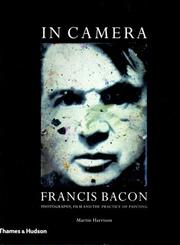
ISBN: 0500238200 Year: 2005 Publisher: London Thames & Hudson
Abstract | Keywords | Export | Availability | Bookmark
 Loading...
Loading...Choose an application
- Reference Manager
- EndNote
- RefWorks (Direct export to RefWorks)
painters [artists] --- conditions and effects [conditions and effects] --- film [performing arts] --- artistieke fotografie --- Film --- film --- Photography --- artists [visual artists] --- Bacon, Francis --- Martin Harrison --- kunst --- Bacon, Francis 1909-1992 (°Dublin, Ierland) --- schilderkunst --- fotografie --- Schilderkunst ; 20ste eeuw ; Francis Bacon --- twintigste eeuw --- Bacon, Francis ; invloed van fotografie, film en andere kunstenaars --- Groot-Brittannië --- Schilderkunst ; Expressionisme ; Nieuwe Figuratie --- 75.07 --- Bacon Francis --- portret --- Deakin John --- schilderkunst en fotografie --- schilderkunst en film --- Eisenstein Sergei --- Muybridge Eadweard --- 75.071 BACON --- Schilderkunst ; schilders --- Bacon, Francis, --- Criticism and interpretation. --- film [discipline]
Book
ISBN: 9780231543217 0231543212 9780231180702 0231180705 9780231180719 0231180713 Year: 2018 Publisher: New York, NY
Abstract | Keywords | Export | Availability | Bookmark
 Loading...
Loading...Choose an application
- Reference Manager
- EndNote
- RefWorks (Direct export to RefWorks)
Taxidermy, once the province of natural history and dedicated to the pursuit of lifelike realism, has recently resurfaced in the world of contemporary art, culture, and interior design. In Speculative Taxidermy, Giovanni Aloi offers a comprehensive mapping of the discourses and practices that have enabled the emergence of taxidermy in contemporary art. Drawing on the speculative turn in philosophy and recovering past alternative histories of art and materiality from a biopolitical perspective, Aloi theorizes speculative taxidermy: a powerful interface that unlocks new ethical and political opportunities in human-animal relationships and speaks to how animal representation conveys the urgency of addressing climate change, capitalist exploitation, and mass extinction.A resolutely nonanthropocentric take on the materiality of one of the most controversial mediums in art, this approach relentlessly questions past and present ideas of human separation from the animal kingdom. It situates taxidermy as a powerful interface between humans and animals, rooted in a shared ontological and physical vulnerability. Carefully considering a select number of key examples including the work of Nandipha Mntambo, Maria Papadimitriou, Mark Dion, Berlinde De Bruyckere, Roni Horn, Oleg Kulik, Steve Bishop, Snæbjörnsdóttir/Wilson, and Cole Swanson, Speculative Taxidermy contextualizes the resilient presence of animal skin in the gallery space as a productive opportunity to rethink ethical and political stances in human-animal relationships.
Oberfläche. --- Tiere (Motiv). --- Stopfpräparat. --- Kunst. --- Dead animals in art. --- Human-animal relationships in art. --- Art, Modern --- Taxidermy --- Themes, motives --- Social aspects. --- Zoological specimens --- Modern art --- Nieuwe Ploeg (Group of artists) --- Themes, motives. --- Collection and preservation --- Faune --- Animal (thème) --- Anthropologie --- De Bruyckere, Berlinde --- Swanson, Cole --- Dion, Mark --- Duchamp, Marcel --- Picasso, Pablo --- Muybridge, Eadweard --- Cézanne, Paul --- Horn, Roni, --- Magritte, René --- Kulik, Oleg --- Horn, Roni, 1955 --- -Magritte, René --- Dead animals in art --- Human-animal relationships in art --- 7.042 --- Taxidermie ; dierenhuid ; pels --- Mntambo, Nandipha --- Papadimitriou, Maria --- De Bruyckere, Berlinde °1964 (°Gent, België) --- Horn, Roni °1955 (°New York, Verenigde Staten) --- Bishop, Steve --- Snæbjörnsdóttir/Wilson (Bryndís Snæbjörnsdóttir & Mark Wilson) --- Social aspects --- Iconografie ; dieren, fauna
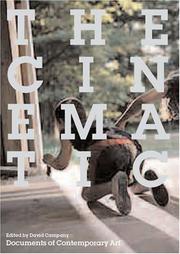
ISBN: 9780262532884 9780854881529 0854881522 0262532883 Year: 2007 Publisher: Cambridge, Mass.: MIT Press, Whitechapel Gallery,
Abstract | Keywords | Export | Availability | Bookmark
 Loading...
Loading...Choose an application
- Reference Manager
- EndNote
- RefWorks (Direct export to RefWorks)
Key writings by artists and theorists chart the shifting relationship between film and photography and how the rise of cinema forced photography to make a virtue of its stillness. The cinematic has been a springboard for the work of many influential artists, including Victor Burgin, Philip-Lorca diCorcia, Stan Douglas, Nan Goldin, Douglas Gordon, Cindy Sherman, and Jeff Wall, among others. Much recent cinema, meanwhile, is rich with references to contemporary photography. Video art has taken a photographic turn into pensive slowness; photography now has at its disposal the budgets and scale of cinema. This addition to Whitechapel's Documents of Contemporary Art series surveys the rich history of creative interaction between the moving and the still photograph, tracing their ever-changing relationship since early modernism. Still photography cinema's ghostly parent was eclipsed by the medium of film, but also set free. The rise of cinema obliged photography to make a virtue of its own stillness. Film, on the other hand, envied the simplicity, the lightness, and the precision of photography. Russian Constructivist filmmakers considered avant-garde cinema as a sequence of graphic "shots"; their Bauhaus, Constructivist and Futurist photographer contemporaries assembled photographs into a form of cinema on the page. In response to the rise of popular cinema, Henri Cartier-Bresson exalted the "decisive moment" of the still photograph. In the 1950s, reportage photography began to explore the possibility of snatching filmic fragments. Since the 1960s, conceptual and postconceptual artists have explored the narrative enigmas of the found film still. The Cinematic assembles key writings by artists and theorists from the 1920s on including László Moholy-Nagy, Pier Paolo Pasolini, Victor Burgin, Jeff Wall, and Catherine David documenting the photography-film dialogue that has enriched both media.
Whitechapel Art Gallery. --- Cinematography --- Photography, Artistic --- Whitechapel Art Gallery --- kunst --- twintigste eeuw --- eenentwintigste eeuw --- kunst en fotografie --- kunst en film --- fotografie --- film --- video --- Akerman Chantal --- Antonioni Michelangelo --- Coleman James --- Crewdson Gregory --- Dean Tacita --- Doherty Willie --- Douglas Stan --- Gordon Douglas --- Marker Chris --- McQueen Steve --- Muybridge Eadweard --- Ristelhueber Sophie --- Trockel Rosemarie --- Sherman Cindy --- Snow Michael --- Viola Bill --- Wall Jeff --- Warhol Andy --- Wenders Wim --- Barthes Roland --- Figgis Mike --- Baudrillard Jean --- Bellour Raymond --- Bragaglia Anton Giulio --- Burgin Victor --- Cartier-Bresson Henri --- David Catherine --- Deleuze Gilles --- Durand Régis --- de Duve Thierry --- Eisenstein Sergei --- Gaensheimer Susan --- Goldin Nan --- Gunning Tom --- Metz Christian --- Mulvey Laura --- Moholy-Nagy Laszlo --- Newhall Beaumont --- Orlow Uriel --- Pasolini Pier Paolo --- Penley Constance --- Prince Richard --- Reich Steve --- Rim Carlo --- Sontag Susan --- Stimson Blake --- Tarantino Michael --- Varda Agnès --- Wollen Peter --- 7.01 --- 7.038 --- 77.01 --- 791.41 --- Cinematography. --- Photography, Artistic. --- Fotografie ; theorie, filosofie, esthetica --- 791.43.01 --- Kunsttheorie ; relatie film en fotografie ; bewegend versus stilstaand beeld --- Cinematografie --- Het filmische in de fotografie --- Het fotografische in de film --- Kunst ; theorie, filosofie, esthetica --- Filmkunst ; theorie, filosofie, esthetica --- film [performing arts] --- hedendaagse kunst --- Film --- photography [process] --- Contemporary [style of art] --- Photography --- Goldin, Nan --- Eisenstein, Sergei M. --- Pasolini, Pier Paolo --- Muybridge, Eadweard --- Sontag, Susan --- Cartier-Bresson, Henri --- Wall, Jeff --- Kracauer, Siegfried --- Wenders, Wim --- Moholy-Nagy, László --- Akerman, Chantal --- Artistic photography --- Photography, Pictorial --- Pictorial photography --- Art --- Chronophotography --- Aesthetics --- Animated pictures --- Motion pictures --- Whitechapel Gallery --- Whitechapel Art Gallery, London --- Iconographie --- Art contemporain --- Processus de création --- Création artistique --- Cinéma --- Photographie --- Fotografie --- film [uitvoerende kunsten] --- film [discipline] --- Art conceptuel --- Art vidéo --- Mouvement moderne --- Werkbund --- Bauhaus --- Constructivisme
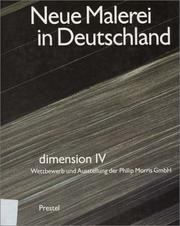

ISBN: 3791306413 Year: 1983 Publisher: München Philip Morris GmbH
Abstract | Keywords | Export | Availability | Bookmark
 Loading...
Loading...Choose an application
- Reference Manager
- EndNote
- RefWorks (Direct export to RefWorks)
Painting --- painting [image-making] --- Nauman, Bruce --- Lechner, Alf --- Schreiter, Johannes --- Morgan, Tony --- Stöver, Dieter --- Glatzel, Matthias --- Berndt, Achim --- Mields, Rune --- Zawadzki, Martin --- Fiala, Natasha --- Stoll, Arthur --- Volles, Wolfgang --- Motherwell, Robert --- Rohling, Gerd --- Muller, Manfred --- Muybridge, Eadweard --- Kettel, Joachim F. --- Hell, ter, Jan --- Fruhtrunk, Günter --- Kupka, Frantz --- Boskamp, Georg --- Dine, Jim --- Hoehme, Gerhard --- Rainer, Arnulf --- Vedova, Emilio --- Banana, Charley --- Partenheimer, Jürgen --- Lakner, László --- Jakubaschke, Sigrun --- Dissel, Rainer --- Hödicke, Karl Horst --- Marey, Étienne-Jules --- Vautier, Ben --- Brosch, Hans --- Puni, Ivan Albertovich --- Twombly, Cy --- Giering, Bernd --- Carrà, Carlo --- Sarkis --- Lehnerer, Thomas --- Middendorf, Helmut --- Benning, Kurt --- Duchamp, Marcel --- Knaupp, Werner --- Löwenstein, Christian --- Schmidt-Heins, Gabriele --- Jaworski, Halina --- Johannes, Ralf --- Schwitters, Kurt --- Christian, Abraham David --- Kirner, Berthold --- Voth, Hansjörg --- Pollock, Jackson --- Bragaglia, Anton Giulio --- Idelberger, Udo --- Balla, Giacomo --- anno 1900-1999 --- Germany --- Painting, German --- Müller, Manfred --- Voth, Hannsjörg --- Banana, Charly --- Duitsland
| Listing 1 - 10 of 16 | << page >> |
Sort by
|

 Search
Search Feedback
Feedback About UniCat
About UniCat  Help
Help News
News